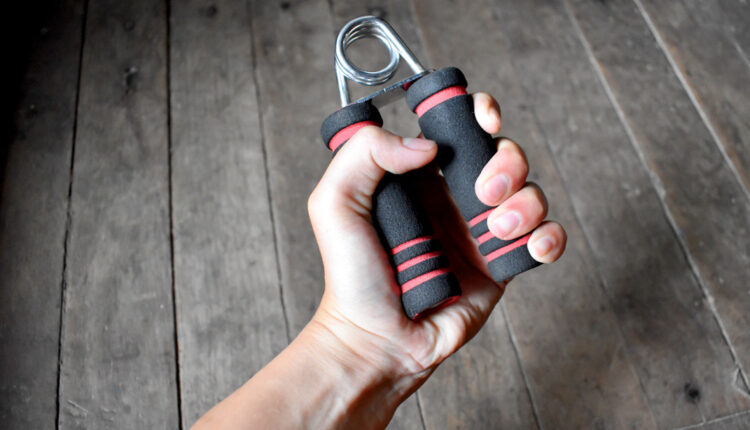Body levers can play a pretty heavy role into what we naturally excel at. People with long arms, for instance, will likely be especially good at throwing, rowing, martial arts, and racquet sports. Taller folks will generally have a size advantage in basketball and volleyball. Large, heavy people can generally lift heavy weights, show impressive grip strength, and do well in strongman and Scottish athletics.
And then there’s people like me. I’m short, I’m light, and I don’t have particularly long limbs. But dammit, I want the gains. I love strongman and other feats of strength that definitely favor people who are far less T-Rex-after-going through-the-dryer than I.
So what’s a small human to do?
Here’s the good news: if you’re short, lifting things is generally going to be easier. If an object has to travel for a shorter distance, it requires a whole lot less work. If you’re low to the ground, deadlifting will come a whole lot easier.
Shorter arms mean super-efficient pressing—hellooo, big bench and overhead press! Short legs generally mean an easier squat. And if you’ve got short arms and a lighter body? You’ll likely be better at pullups than the average bear. Because many of the standard lifts are more efficient for us smaller folk, it can become a lot easier for us to become very strong, pound-for-pound.
But here’s where we may be losing out: grip strength. If you can’t hang on to the bar, the lift isn’t happening. For any lifter, grip strength tends to be the limiting factor in many moves. When your hands are smaller, they don’t wrap around the bar quite as well as those of a longer-fingered lifter, so your chances of losing your grip on your lifting apparatus are generally going to be higher.
THE FIX TO GETTING A STRONGER GRIP
I’m a big proponent of training the weakest link, and for Team Tiny Hands in particular, the grip is likely to be a detrimental disadvantage for most of us. However, all hope for lifting heavy objects is not lost. The following tried-and-true methods of building an iron grip will help back up those big lifts you’re primed to tackle.
- Thick-bar training
The thicker the bar, the harder it is to hold onto, and learning how to manage a thick bar can translate to a much more solid hold on a standard bar. Thick-bar training can improve grip strength—and there are a lot of ways to add to the circumference of a bar.If you’re in the market for another barbell to add to your collection, an axle bar could be just what you need—the diameter is generally 50mm, nearly double that of a 25mm- to-28mm-diameter of any standard Olympic barbell.If you want to keep it simple, you can invest in a pair of Fat Gripz, which simply snap onto a regular barbell and add varying grip widths. Simpler yet, wrap a washcloth or towel around the areas you’re planning to grip. The more the cloth wraps around the bar, the thicker the gripping area.
Because thick-bar training is a significantly less efficient way to hold on to a bar, you will simply not be able to pull as much weight as you would be able to utilizing a standard bar. Therefore, it’s important to include thick-bar training as a supplement to, and not a substitute for, heavy barbell training. In fact, one study demonstrated that in those training with Fat Gripz, forearm and deltoid muscles worked overtime in deadlift, pullups, and bentover row. However, upper-arm muscle activity decreased significantly as compared to doing these movements without the thick bar. Get the best of both worlds—don’t neglect the heavy stuff!
- Deadlift with an overhand grip
Save the mixed grip only for when you can no longer pick up the bar with an overhand grip. This is a great way of getting your hands stronger on big weights, and improving your ability to hang on to the bar. - Try heavy holds for time
Holding on to the barbell at the top of a deadlift for eight to 10 seconds or so can help build grip endurance and strength, plus can teach your body how to lock out that weight for longer periods of time. Exercises such as farmer’s carries and heavy shrugs can similarly condition your grip. - Plate pinches for time
Try grabbing two weight plates, ideally with smooth back surfaces. Hold the plates together, smooth side out, between your fingers and thumbs. You can do this one-handed or two-handed, and you can do loaded carries in this manner, too. This is a fantastic way to improve your pinch-grip strength and your thumb’s ability to help stabilize a weight. - Wrist Training
If you’re generally a smaller person, chances are, your wrists are on the small side, too. Improving wrist strength and stability leads to stronger forearms and more stable, powerful pressing and lifting. Wrist curls, both prone and supine, and wrist rollers are extremely useful tools in the building of wrist strength. That said, we often forget that the wrist moves in more directions than simply up and down. Yo-yo type rollers are an excellent tool for training the lateral movements of the wrist, while sledgehammer levering and rotations are a great way to build wrist strength at odd angles and leverages.
The best way to get better at lifting heavy weights is to, well, lift heavy weights. But improving grip strength can really give us smaller folks—and everyone else, really—the ability to handle more weight confidently, pack on some serious forearm muscles, and go after those gains more effectively than ever.
Melody Schoenfeld, C.S.C.S., is an award-winning trainer, international speaker, coach. Schoenfeld is also co-author (with Lee Boyce) of the recently released Strength Training for All Body Types: The Science of Lifting and Levers.
She can be found on social media: @5ftoffury1


Comments are closed.